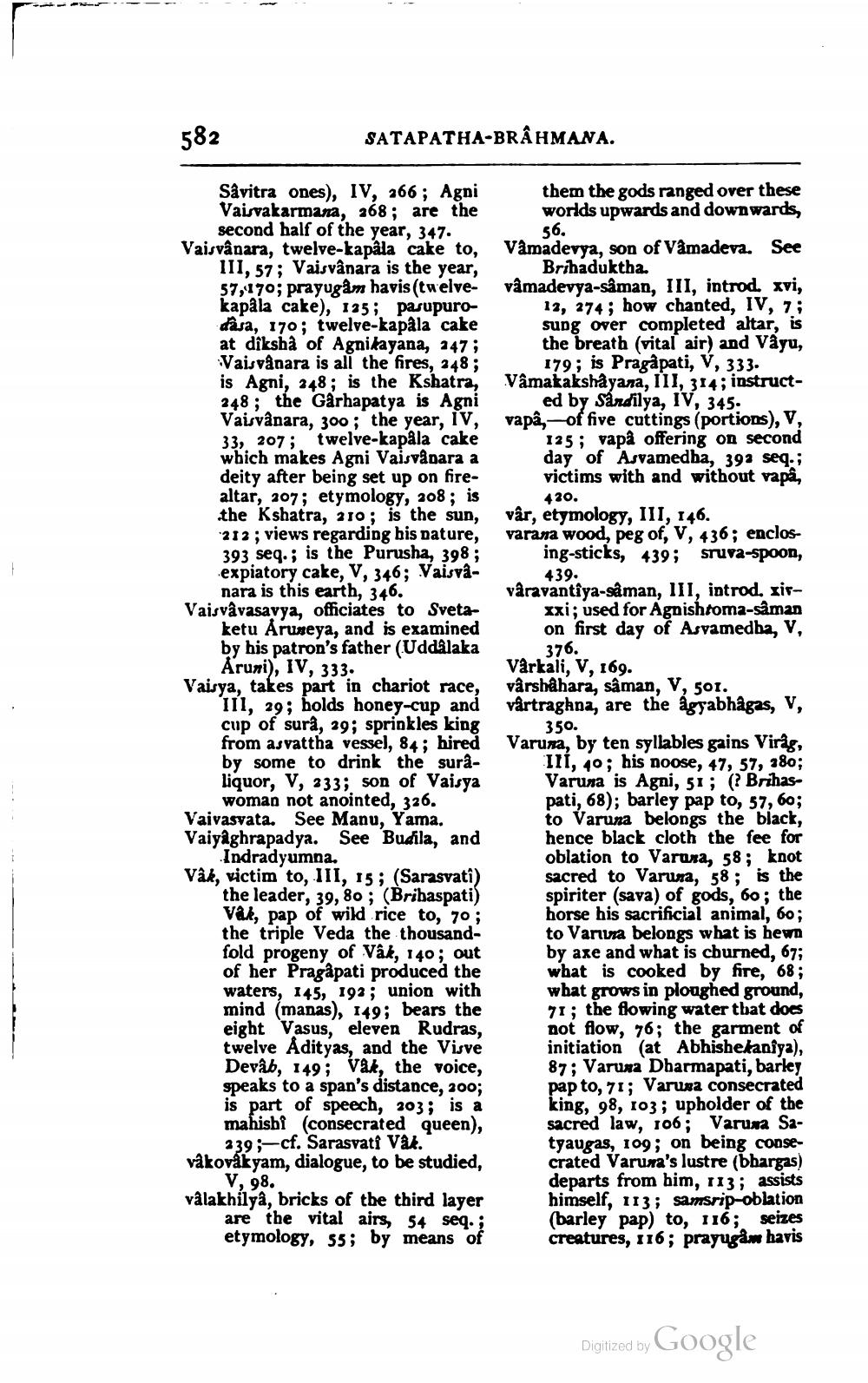________________
582
SATAPATHA-BRAHMANA.
Såvitra ones), IV, 266; Agni Vaisvakarmana, 268; are the
second half of the year, 347. Vaisvânara, twelve-kapala cake to,
III, 57; Vaisvânara is the year, 57,170; prayugam havis (twelve- kapala cake), 135; pasupuroatása, 170; twelve-kapala cake at diksha of Agnilayana, 247; Vaisvanara is all the fires, 248; is Agni, 248; is the Kshatra, 248; the Garhapatya is Agni Vaisvânara, 300; the year, IV, 33, 207; twelve-kapåla cake which makes Agni Vaisväpara a deity after being set up on firealtar, 107; etymology, 208; is the Kshatra, 210 ; is the sun, 212; views regarding bis nature, 393 seq. ; is the Purusha, 398; expiatory cake, V, 346; Vaisva
nara is this earth, 346. Vaisvavasavya, officiates to Sveta
ketu Aruneya, and is examined by his patron's father (Uddalaka
Aruni), IV, 333. Vaisya, takes part in chariot race,
III, 29; holds honey-cup and cup of sura, 29; sprinkles king from asvattha vessel, 84; hired by some to drink the suraliquor, V, 233; son of Vaisya
woman not anointed, 326. Vaivasvata. See Manu, Yama. Vaiyaghrapadya. See Budila, and
Indradyumna. Våk, victim to, III, 15; (Sarasvati)
the leader, 39, 80; (Brihaspati) Vak, pap of wild rice to, 70 ; the triple Veda the thousandfold progeny of Vak, 140; out of her Pragàpati produced the waters, 145, 192; union with mind (manas), 149; bears the eight Vasus, eleven Rudras, twelve Adityas, and the Visve Devåb, 149; Val, the voice, speaks to a span's distance, 300; is part of speech, 203; is a mahishi (consecrated queen),
239;-cf. Sarasvati Våk. vákovák yam, dialogue, to be studied,
V, 98. valakhilya, bricks of the third layer
are the vital airs, 54 seq. ; etymology, 55; by means of
them the gods ranged over these worlds upwards and downwards,
56. Vamadevya, son of Vâmadeva. See
Brihaduktha. vâmadevya-saman, III, introd. xvi,
12, 274; how chanted, IV, 7; sung over completed altar, is the breath (vital air) and Vayu,
179; is Pragàpati, V, 333. Vâmatakshayana, 111, 314; instruct
ed by Sárdilya, IV, 345. . vapa,- of five cuttings (portions), V,
125; vapå offering on second day of Asvamedha, 391 seq.; victims with and without rapa,
420. vâr, etymology, III, 146. varana wood, peg of, V, 436; enclos
ing-sticks, 439; sruva-spoon,
439. våravantîya-saman, III, introd, xir
xxi; used for Agnishtoma-saman on first day of Asyamedha, V,
376. Varkali, V, 169. vârshåhara, sâman, V, 501. vårtraghna, are the ágyabhāgas, V,
350. Varuna, by ten syllables gains Virág,
III, 40; his noose, 47, 57, 380; Varuna is Agni, 51; (? Brihaspati, 68); barley pap to, 57, 60; to Varuna belongs the black, hence black cloth the fee for oblation to Varuna, 58; knot sacred to Varura, 58; is the spiriter (sava) of gods, 60; the horse his sacrificial animal, 60; to Varuva belongs what is hewn by axe and what is churned, 67; what is cooked by fire, 68; what grows in ploughed ground, 71; the flowing water that does not flow, 76; the garment of initiation (at Abhishekaniya), 87; Varuxa Dharmapati, barley pap to, 71; Varusa consecrated king, 98, 103; upholder of the sacred law, 106; Varuxa Satyaugas, 109; on being consecrated Varuna's lustre (bbargas) departs from him, 113; assists himself, 113; samsrip-oblation (barley pap) to, 116; seizes creatures, 116; prayugim havis
Digitized by Google




